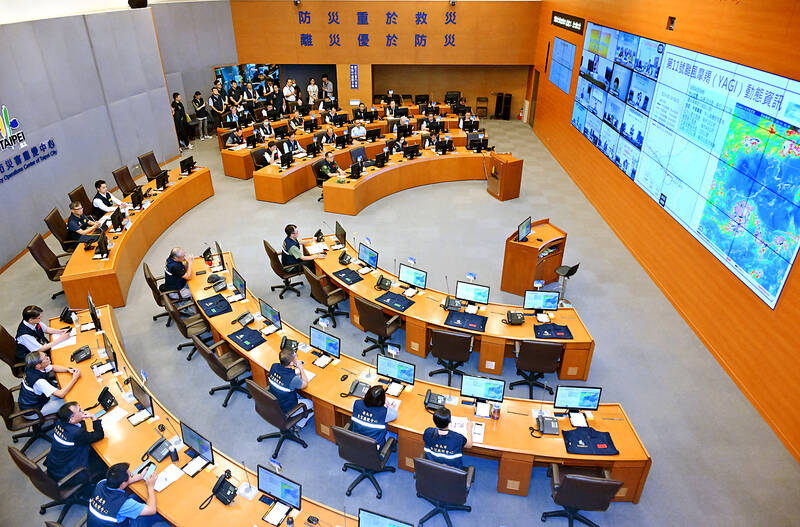As Tropical Storm Bebinca barrels toward waters off northern Taiwan gathering strength into a possible typhoon, weather forecasters in Taipei are using a new and so far successful method to help track its path: artificial intelligence (AI).
AI-generated forecasts, some powered by software from tech giants including Nvidia, whose chips are made by Taiwan’s homegrown semiconductor champion Taiwan Semiconductor Manufacturing Co, have so far outperformed traditional methods in predicting typhoon tracks.
In July, it was AI-based weather models, used for the first time, that helped Taiwan better predict the path and impact of Typhoon Gaemi, the strongest to strike the nation in eight years that brought record-breaking rainfall.

Photo: Liao Chen-huei, Taipei Times
The new technology impressed Taiwanese forecasters by predicting a direct hit as early as eight days before Gaemi made landfall, handily outperforming conventional methods, which remain the mainstay of prediction planning.
“People are starting to realize AI indeed delivered some stunning performances compared to conventional models,” Taiwan Integrated Disaster Prevention of Technology Engineering Consulting Co director Chia Hsin-sing (賈新興) said.
Bebinca is being tracked using the same AI tools by people including Lin Ping-yu (林秉煜), a forecaster at the Central Weather Administration (CWA), who said that AI has given the agency a higher degree of confidence there would not be a direct hit.
“This [AI] is a good thing for us. It is like having one more useful tool to use,” Lin said.
The AI weather programs on offer include Nvidia’s FourCastNet, Google’s GraphCast and Huawei’s Pangu-Weather, as well as a deep learning-based system by the European Centre for Medium-Range Weather Forecasts.
“It is a hotly watched competition. We will know soon who is winning,” Chia said.
Such AI models have also begun to be used to predict storms and hurricanes in other regions with good accuracy, forecasters and academics say.
The AI-based software is trained using historical weather data to learn the cause and effect relationships of meteorological systems and can predict hundreds of weather variables days in advance — a process that requires only a few minutes to complete.
For all the typhoons in the western Pacific this year until the middle of this month, AI’s accuracy in predicting storm tracks over a three-day window was nearly 20 percent higher than that of conventional models, data compiled by the CWA showed.
Ahead of Gaemi, AI helped the CWA foresee an unusual loop in its path that prolonged its impact on Taiwan and prompted it to swiftly issue a rare warning for rainfall of 1.8m, which was later proven accurate, CWA Deputy Administrator Lu Kuo-chen (呂國臣) said.
AI “boosted the confidence for forecasters to make that prediction,” Lu said, adding that the early warning gave extra time for authorities to carry out preparations.
Lu is also pinning hopes on a partnership with Nvidia, which this year announced a generative AI tool called CorrDiff that aims to forecast more precise locations of typhoon landfall and provide higher resolution images inside a storm.
“We are seeing the potential,” Lu said.
However, for now experts say the AI tools were not able to deliver quality forecasts for more detailed impact of a typhoon, such as its strength and winds, and more time is needed for the new technology to solidify its lead over more traditional ways.
“Was it just good luck?” Chia asked, pointing to AI’s stellar performance on Gaemi. “We need to give AI a bit more time. It is something to look forward to.”
AI is also being used to forecast wave patterns, with the system expected to be fully operational by 2026 in 16 of the 22 administrative regions in Taiwan, the CWA said.
Twelve monitoring stations and several forecasting systems have been established nationwide to improve safety for recreational water activities, the agency said.
Pilot programs are under way along the north coast and at the Northeast and Yilan Coast National Scenic Area, it said.
The CWA said it has partnered with local research institutions to develop rip current monitoring and forecasting tools.
Using AI, they are producing detailed wave forecasts to enhance the safety of coastal recreation and other operations, it added.
Additional reporting by CNA

Chinese Nationalist Party (KMT) Chairman Eric Chu (朱立倫), spokeswoman Yang Chih-yu (楊智伃) and Legislator Hsieh Lung-chieh (謝龍介) would be summoned by police for questioning for leading an illegal assembly on Thursday evening last week, Minister of the Interior Liu Shyh-fang (劉世芳) said today. The three KMT officials led an assembly outside the Taipei City Prosecutors’ Office, a restricted area where public assembly is not allowed, protesting the questioning of several KMT staff and searches of KMT headquarters and offices in a recall petition forgery case. Chu, Yang and Hsieh are all suspected of contravening the Assembly and Parade Act (集會遊行法) by holding

PRAISE: Japanese visitor Takashi Kubota said the Taiwanese temple architecture images showcased in the AI Art Gallery were the most impressive displays he saw Taiwan does not have an official pavilion at the World Expo in Osaka, Japan, because of its diplomatic predicament, but the government-backed Tech World pavilion is drawing interest with its unique recreations of works by Taiwanese artists. The pavilion features an artificial intelligence (AI)-based art gallery showcasing works of famous Taiwanese artists from the Japanese colonial period using innovative technologies. Among its main simulated displays are Eastern gouache paintings by Chen Chin (陳進), Lin Yu-shan (林玉山) and Kuo Hsueh-hu (郭雪湖), who were the three young Taiwanese painters selected for the East Asian Painting exhibition in 1927. Gouache is a water-based

Taiwan would welcome the return of Honduras as a diplomatic ally if its next president decides to make such a move, Minister of Foreign Affairs Lin Chia-lung (林佳龍) said yesterday. “Of course, we would welcome Honduras if they want to restore diplomatic ties with Taiwan after their elections,” Lin said at a meeting of the legislature’s Foreign Affairs and National Defense Committee, when asked to comment on statements made by two of the three Honduran presidential candidates during the presidential campaign in the Central American country. Taiwan is paying close attention to the region as a whole in the wake of a

OFF-TARGET: More than 30,000 participants were expected to take part in the Games next month, but only 6,550 foreign and 19,400 Taiwanese athletes have registered Taipei city councilors yesterday blasted the organizers of next month’s World Masters Games over sudden timetable and venue changes, which they said have caused thousands of participants to back out of the international sporting event, among other organizational issues. They also cited visa delays and political interference by China as reasons many foreign athletes are requesting refunds for the event, to be held from May 17 to 30. Jointly organized by the Taipei and New Taipei City governments, the games have been rocked by numerous controversies since preparations began in 2020. Taipei City Councilor Lin Yen-feng (林延鳳) said yesterday that new measures by